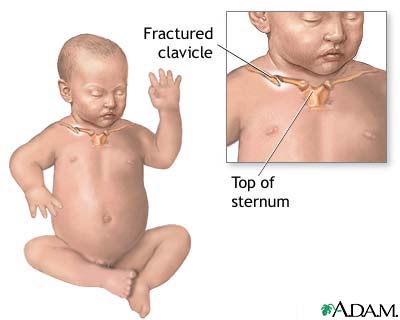Health Library
Fractured clavicle in the newborn
Fractured collar bone - newborn; Broken collar bone - newborn
A fractured clavicle in the newborn is a broken collar bone in a baby that was just delivered.
Images

I Would Like to Learn About:
Causes
A fracture of a newborn's collar bone (clavicle) can occur during a difficult vaginal delivery.
Symptoms
The baby will not move the painful, injured arm. Instead, the baby will hold it still against the side of the body. Lifting the baby under the arms causes the child pain. Sometimes, the fracture can be felt with the fingers, but the problem often can't be seen or felt.
Within a few weeks, a hard lump may develop where the bone is healing. This lump may be the only sign that the newborn had a broken collar bone.
Exams and Tests
A chest x-ray will show whether or not there is a broken bone.
Treatment
In general, there is no treatment other than lifting the child gently to prevent discomfort. If needed, the arm on the affected side may be kept still by simply pinning the sleeve to the clothes.
Outlook (Prognosis)
Full recovery occurs without treatment.
Possible Complications
Most often, there are no complications. Because infants heal well, it may be impossible (even by x-ray) to tell that a fracture occurred.
When to Contact a Medical Professional
Contact your health care provider if your baby acts uncomfortable when you lift them.
References
Baldwin KD, Shah AS, Wells L, Arkader A. Common fractures. In: Kliegman RM, St. Geme JW, Blum NJ, Shah SS, Tasker RC, Wilson KM, eds. Nelson Textbook of Pediatrics. 21st ed. Philadelphia, PA: Elsevier; 2020:chap 703.
Prazad PA, Rajpal MN, Mangurten HH, Puppala BL. Birth injuries. In: Martin RJ, Fanaroff AA, Walsh MC, eds. Fanaroff and Martin's Neonatal-Perinatal Medicine Diseases of the Fetus and Infant. 11th ed. Philadelphia, PA: Elsevier; 2020:chap 29.
BACK TO TOPReview Date: 8/5/2023
Reviewed By: Neil K. Kaneshiro, MD, MHA, Clinical Professor of Pediatrics, University of Washington School of Medicine, Seattle, WA. Also reviewed by David C. Dugdale, MD, Medical Director, Brenda Conaway, Editorial Director, and the A.D.A.M. Editorial team.
 | A.D.A.M., Inc. is accredited by URAC, for Health Content Provider (www.urac.org). URAC's accreditation program is an independent audit to verify that A.D.A.M. follows rigorous standards of quality and accountability. A.D.A.M. is among the first to achieve this important distinction for online health information and services. Learn more about A.D.A.M.'s editorial policy, editorial process and privacy policy. A.D.A.M. is also a founding member of Hi-Ethics. This site complies with the HONcode standard for trustworthy health information: verify here. |
The information provided herein should not be used during any medical emergency or for the diagnosis or treatment of any medical condition. A licensed medical professional should be consulted for diagnosis and treatment of any and all medical conditions. Links to other sites are provided for information only -- they do not constitute endorsements of those other sites. No warranty of any kind, either expressed or implied, is made as to the accuracy, reliability, timeliness, or correctness of any translations made by a third-party service of the information provided herein into any other language. © 1997- 2025 A.D.A.M., a business unit of Ebix, Inc. Any duplication or distribution of the information contained herein is strictly prohibited.
